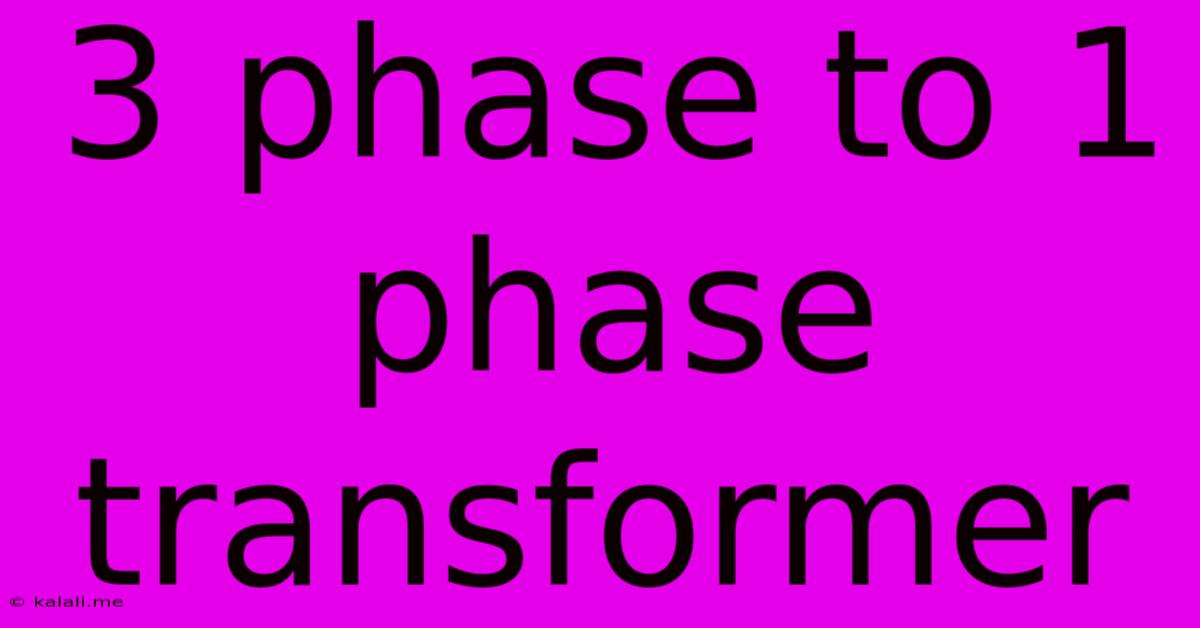3 Phase To 1 Phase Transformer
Kalali
May 22, 2025 · 4 min read

Table of Contents
3-Phase to 1-Phase Transformer: A Comprehensive Guide
Meta Description: Learn about 3-phase to 1-phase transformers, their applications, types, and how they efficiently convert three-phase power to single-phase power for various residential and industrial needs. This guide covers Scott-T, open-delta, and zig-zag connections.
Three-phase power is the standard for high-power electrical distribution, offering efficiency and reliability. However, many residential and industrial applications require single-phase power. This is where the 3-phase to 1-phase transformer comes into play. These transformers are crucial components in converting the higher voltage, three-phase power supply into the lower voltage, single-phase power needed by various equipment and appliances. This article will delve into the functionality, different connection types, and applications of these essential electrical devices.
Understanding the Transformation
A 3-phase to 1-phase transformer doesn't simply "reduce" the voltage; it performs a complex transformation to convert the three-phase power's alternating current (AC) waveform into a single-phase waveform. This involves carefully managing the voltage and current relationships between the three input phases and the single output phase. The process maintains power balance, ensuring efficient energy transfer without significant losses. The core principle involves using the transformer's windings to selectively utilize portions of the three-phase power to generate a single-phase output.
Common Connection Types and Configurations
Several connection methods exist for transforming three-phase power to single-phase power, each with its advantages and disadvantages. Here are some of the most prevalent:
1. Scott-T Connection: This configuration is known for its balanced output and is frequently used for supplying single-phase loads from a three-phase supply. It employs two transformers: a "main" transformer and a "teaser" transformer. The main transformer is connected across two phases, while the teaser is connected across one phase and the neutral point (if available) of the three-phase system. This arrangement produces two single-phase outputs that are 90 degrees out of phase with each other. This method is particularly effective for providing power to loads requiring balanced single-phase power.
2. Open-Delta Connection: Also known as V-V connection, this method utilizes only two transformers connected in an open delta configuration. It's a simpler setup compared to the Scott-T connection but offers less efficient power utilization. While less efficient, it's cost-effective and provides a solution when a single-phase load needs to be powered from a three-phase source and only two transformers are available. This method is often employed as a temporary solution or in smaller installations where cost is a significant factor.
3. Zig-Zag Connection: The zig-zag connection uses multiple windings on each transformer core. This design excels in suppressing harmonics in the output, producing cleaner single-phase power compared to other methods. This configuration is frequently chosen when the load requires a higher-quality single-phase supply with minimal harmonic distortion. However, it's generally more complex and expensive compared to the simpler open-delta method.
Applications of 3-Phase to 1-Phase Transformers
These transformers find applications in diverse sectors:
- Residential Areas: In areas with a three-phase distribution network but individual houses requiring single-phase power, these transformers are essential for stepping down the voltage to safe residential levels.
- Industrial Settings: Many industrial machines and equipment may operate on single-phase power, even within a larger three-phase infrastructure. These transformers ensure that the necessary power is available for these machines.
- Commercial Buildings: Commercial establishments often have a mix of three-phase and single-phase equipment, requiring the use of these transformers to cater to the varying power needs.
- Power Distribution Systems: These transformers are crucial for effectively distributing power within a three-phase network, adapting to the varied power requirements of individual consumers and equipment.
Choosing the Right Transformer
Selecting the appropriate 3-phase to 1-phase transformer depends on several factors:
- Power Rating: The transformer must have a sufficient power rating to handle the load.
- Voltage Levels: The input and output voltage levels should match the system's requirements.
- Connection Type: The choice of connection (Scott-T, open-delta, or zig-zag) depends on the specific needs of the application and the desired output quality.
- Efficiency and Harmonics: Consider the efficiency of the transformer and the level of harmonic distortion acceptable for the load.
By understanding the different types and applications of 3-phase to 1-phase transformers, engineers and technicians can select the most suitable solution for various power distribution needs, guaranteeing efficient and reliable power supply for a diverse range of applications.
Latest Posts
Latest Posts
-
Can I Change My Name In Pokemon Go
May 22, 2025
-
How To Turn Off The Hot Water Supply
May 22, 2025
-
How Much Water Is In A Radiator
May 22, 2025
-
Can You Pray Fajr Before Sunrise
May 22, 2025
-
A Woman After My Own Heart Meaning
May 22, 2025
Related Post
Thank you for visiting our website which covers about 3 Phase To 1 Phase Transformer . We hope the information provided has been useful to you. Feel free to contact us if you have any questions or need further assistance. See you next time and don't miss to bookmark.